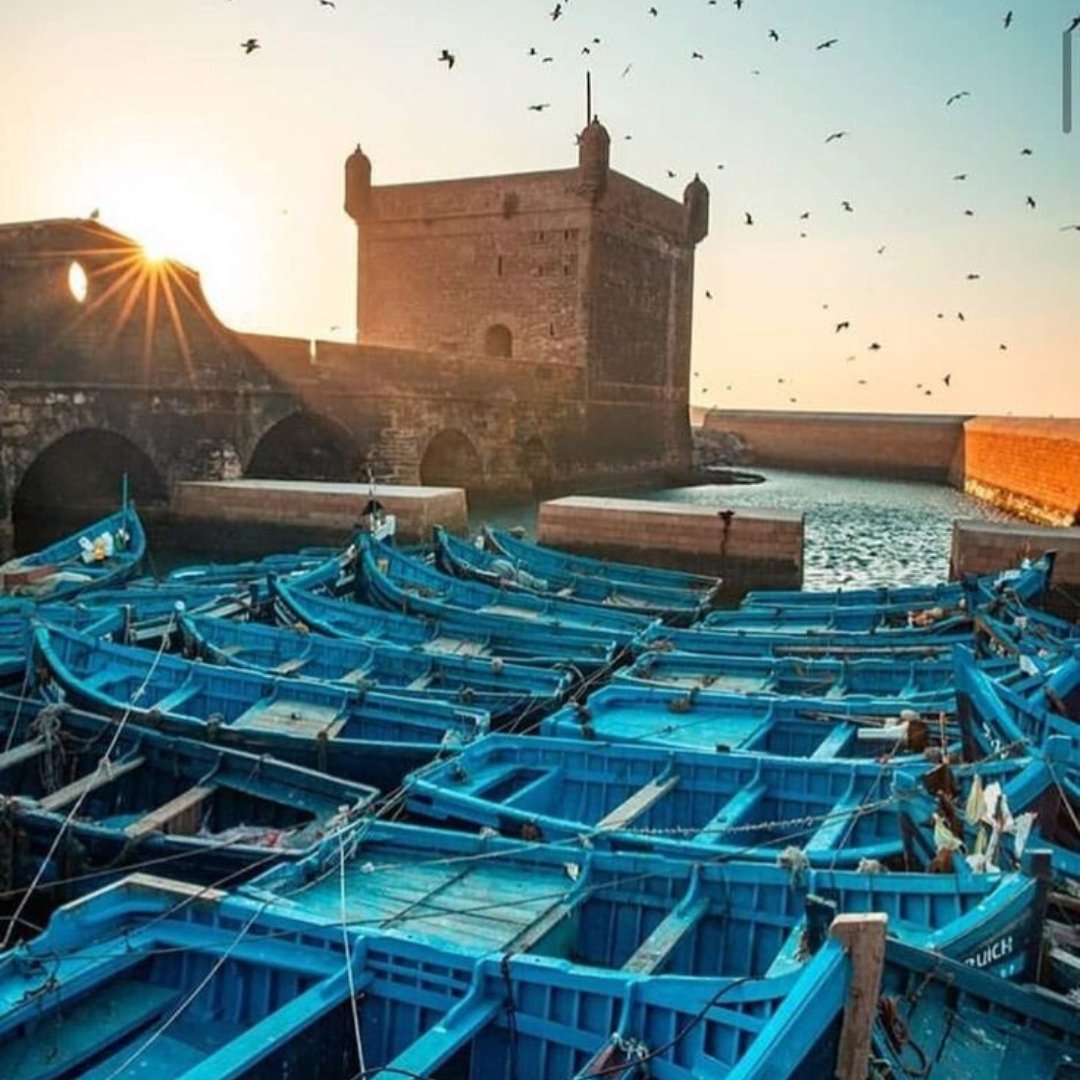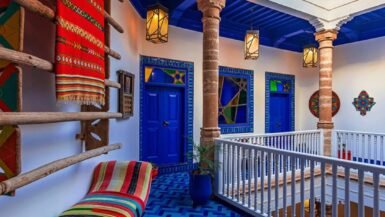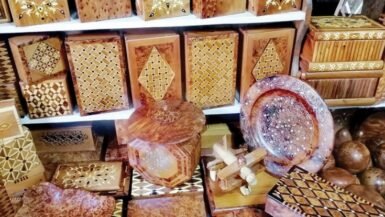Essaouira is the city of winds and magic, offering its visitors a unique experience that goes beyond merely exploring Essaouira’s historical landmarks to include nature, art, and music. In this comprehensive guide to tourist attractions in Essaouira, we present the landmarks that make this coastal city an unforgettable destination for visitors from around the world, just like the other imperial cities Tangier, Rabat, and Marrakech.
In this guide, we present the most prominent tourist attractions in Essaouira that make this city an unforgettable destination, from Essaouira Beach and the historic Essaouira Port and the defensive Skala of the City, to the vitality of city markets, the world of Gnawa Festival, the beauty of Argan Forest and Mogador Island, and art in Dar Souiri and art galleries. We will also address traditional products in Essaouira, cuisine in Essaouira, and accommodation in Essaouira.
Essaouira’s Coastal Icons: Beach, Skala, and Port
The Essaouira experience usually begins from its charming seafront, where the most prominent tourist attractions related to coast and beaches and the city’s defensive history are embodied. This area extends from the historic city walls to the ancient port that reflects the city’s maritime heritage…
Essaouira Beach
The wide sandy Essaouira Beach stretches along the city’s seafront and is considered one of the most beautiful and distinctive Moroccan beaches. The beach is famous for its strong winds that have made it a global destination for windsurfing and kitesurfing sports.
Visitors can enjoy a walk on the golden sands, try camel and horse riding, or relax in one of the cafés overlooking the sea. What distinguishes Essaouira Beach as one of the most important tourist attractions is its unique blend of stunning nature and opportunities to practice exciting water sports.
Skala of the City (Skala of the Medina)
Essaouira includes two fortified defensive platforms known as Skala of the City, which are among the most prominent historical and tourist landmarks in the city and form part of the historic city walls:
- Skala of the Kasbah: Located within the old city (Kasbah) and overlooking the sea and Mogador Island, it is famous for being the best place to watch the sunset in Essaouira. This platform includes huge historical cannons that were used to defend the city. For more information about the city’s history, you can visit the official Moroccan tourism website.
- Port Skala: Located near the port entrance and provides panoramic views of fishermen’s activity and blue boats.
The Skala is considered one of the most important tourist attractions in Essaouira thanks to its historical and architectural value and the panoramic views it provides visitors of the city and ocean.
Essaouira Port
Essaouira Port is one of the oldest and most vibrant Moroccan ports, still maintaining its traditional character and functioning as an active fishing port. The small blue boats lined up along the port are distinguished by their magnificent view that attracts photographers from around the world.
Visitors can watch fishermen returning with the day’s catch, the vibrant fish market, and flocks of seagulls spread in the atmosphere. The authentic atmosphere and smells of the sea and fresh fish make Essaouira Port one of the most authentic tourist attractions connected to the city’s life and maritime history.
Essaouira’s Old City: Markets, Art, and Traditional Life
Behind Essaouira’s historic walls lies the old city (UNESCO-listed), with its maze of charming alleys that house city markets and art galleries. This area includes important historical landmarks such as the Great Mosque, Zaouia of Sidi Maimoun, and Pasha’s Tower, in addition to Christian monuments like the Portuguese Church. The city also includes Essaouira’s Mellah (Jewish quarter) which contains Simon Synagogue and the tomb of Rabbi Haim Pinto. For more information about Essaouira’s heritage, you can visit the UNESCO website…
City Markets (Traditional Souks)
The city markets of old Essaouira are smaller and quieter than markets in other Moroccan cities like Marrakech or Fes, making them easier to explore and less exhausting for visitors. These markets are famous for their distinctive handicraft products, especially:
- Woodwork made from precious thuya wood
- Traditional leather products
- Handmade textiles
- Artistic paintings
- Spices and aromatic herbs
- Local souvenirs
City markets are among the most important tourist attractions in Essaouira for those who want to shop and acquire authentic handicraft products, in addition to enjoying the city’s traditional atmosphere and interacting with local residents.
Dar Souiri and Art Galleries
Dar Souiri represents an important cultural center in the heart of the old city, hosting many cultural and artistic events throughout the year, especially those related to Gnawa music. For updated information about events, you can visit the official Gnawa Festival website.
Art galleries are also spread throughout different parts of the old city, displaying works by local and international artists – paintings and sculptures that reflect Essaouira’s spirit and culture. These galleries and cultural centers constitute an essential destination for art and culture lovers, reflecting the creative character that distinguishes Essaouira as one of the most important tourist attractions with an artistic character.
Unique Experiences Around Essaouira: Festivals, Islands, and Argan Forests
In addition to its tangible landmarks, Essaouira offers unique experiences related to its music and surrounding nature, making it one of the most prominent tourist attractions with a special character…
Gnawa and World Music Festival (Global Event)
The Gnawa and World Music Festival is one of the most prominent music festivals in Morocco and the African continent, held annually in June. The festival focuses on presenting traditional Gnawa music alongside other types of world music, attracting thousands of visitors from around the world.
During the festival period, all of Essaouira transforms into a vibrant tourist destination, with concerts held in different parts of the city. Even outside the festival period, visitors can watch Gnawa musicians performing in cafés and near the Skala, making music an essential part of the city’s identity.
Mogador Island (Historical Island and Bird Reserve)
Mogador Island (the historical name of Essaouira) is located a short distance from the coast and can be clearly seen from the Skala and beach. The island carries great historical importance, with remains of an old Portuguese fort.
The island is today a natural bird reserve, especially for Eleonora’s falcons, which are rare species. Note that access to the island is generally restricted or requires special permission for visits. Mogador Island represents one of the important tourist attractions for history and nature lovers, even if viewing is usually done from afar.
Argan Forest and Argan Oil Cooperatives (Experience Near Essaouira)
The Argan Forest surrounds Essaouira city and is located a short drive from the city. The region is famous for its rare argan trees that only grow naturally in Morocco, used in producing argan oil globally renowned for its nutritional and cosmetic benefits.
Visitors can visit the women’s cooperatives spread throughout the region, observe the traditional method of extracting argan oil, and purchase high-quality natural products. Visiting the argan forest and cooperatives represents a unique tourist experience easily accessible from Essaouira, combining enjoying nature with discovering local traditions.
Importance of These Tourist Attractions in Essaouira
The importance of these tourist attractions in Essaouira lies in their collective formation of the city’s unique identity as a harmonious blend of history, maritime life, art, music, and nature. These landmarks offer visitors a complete experience that combines:
- Rich history represented by the Skala, walls, and old city
- Stunning nature of beaches, forests, and islands
- Vibrant culture through festivals, art, and music
- Authentic daily life in the port and traditional markets
Visiting these diverse tourist attractions is the key to understanding Essaouira’s magic and discovering what distinguishes it from other Moroccan cities.
Visiting Tourist Attractions in Essaouira: Practical Guide and Important Tips
To make the most of your visit to tourist attractions in Essaouira, here are some practical tips for transportation and exploration…
Getting Around Essaouira and Its Surroundings
Essaouira is characterized by its relatively small size, making transportation easy and comfortable:
- Old City: Can be explored on foot, with most landmarks (old city, city markets, city Skala, Essaouira port) located close to each other.
- Small taxis: Available for transportation to southern beach areas or reaching hotels outside the old city.
- Organized tours or taxis: Necessary for visiting external sites like the argan forest or elevated points for viewing Mogador Island.
Operating Hours and Entry Fees (for Visitable Sites)
- Open and free sites: Most main tourist attractions in Essaouira (Essaouira Beach, City Skala, Essaouira Port, general wandering in the old city and markets) are open all day and free of charge.
- Sites with specific hours: Dar Souiri and art galleries have specific operating hours and sometimes symbolic entry fees. It’s advised to check schedules in advance.
- Cooperatives in argan forest: Usually operate during daylight hours, considering rest times.
- Gnawa Festival: Held on specific dates (usually in June) and requires tickets for main concerts.
- Mogador Island: Has restricted access and requires special permits.
Best time to visit Essaouira: Although winds are strong year-round (which makes the city ideal for water sports), spring and autumn are considered the best times to visit thanks to moderate weather. Summer is crowded with tourists but can be very windy at times.
Accommodation in Essaouira: Accommodation options vary from traditional riads in the old city to modern hotels on the beach. For booking and comparing options, you can visit Booking.com or TripAdvisor.
Winds: Essaouira is known as the “city of winds,” and this characteristic affects activities (excellent for water sports, can be cold even in summer, brings flocks of seagulls).
Visit etiquette: It’s advised to wear modest clothing, especially in the old city (although the general atmosphere is more liberal than Fes or Marrakech). Permission should be requested before photographing people, especially in the port.
Shopping: You can bargain on prices in markets, as is the case in other traditional Moroccan souks.
Conclusion: Essaouira… A Diverse Tourist Destination Combining History, Art, and Adventure
Tourist attractions in Essaouira offer a unique experience that combines the fragrance of history, natural beauty, and the vitality of art and music. From its magnificent beach and traditional port and historic City Skala, to the charm of old city markets, the vitality of Gnawa Festival, and the beauty of Argan Forest and Mogador Island, Essaouira possesses all the elements that make it an unforgettable tourist destination.
Use this guide to plan your visit to the most prominent tourist attractions in Essaouira, and prepare to experience the city’s winds and charming atmosphere. For more tourist information about Morocco, you can visit the official website of the Moroccan National Tourism Office. Don’t hesitate to share your own experiences or favorite places in Essaouira after visiting this wonderful city.






Leave a reply